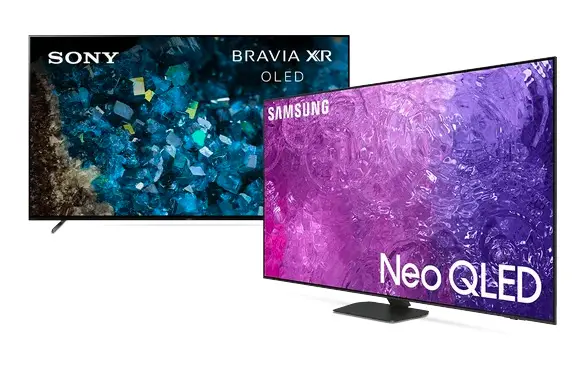
Television is a focal point in many Canadian homes. Whether you’re watching the latest hockey match or bingeing on a new series, the size and placement of your TV can significantly impact your viewing experience. This article will explore how TVs are measured and discuss the significance of understanding TV size.
The basics of TV measurement
The size of a television, often measured in inches, refers to the diagonal length of the screen—from one corner to its opposite (as shown in the image at the top). It’s not about the width or the height of the television, as some might assume. Instead, this diagonal measurement provides a consistent standard, regardless of the actual proportions of the TV. So, when someone mentions a “65 inch TV”, they are referring to the diagonal length of the viewable screen, not the width or height.
Popular TV dimensions: a closer look
Here is a break down of some of the most popular TV dimensions to help you get a clearer understanding of the options available:
- 65 inch tv dimensions: Perfect for a spacious living room or home theatre, this size offers an immersive experience, especially when viewing high-definition content.
- 55 inch tv dimensions: A versatile option, the 55-inch TV fits comfortably in medium to large rooms. It’s a favourite for many Canadian households, striking a balance between size and practicality.
- 75 inch and 85 inch tv dimensions: Ideal for large rooms or dedicated entertainment spaces, these sizes are for those who prioritize a big screen experience. They are especially recommended for ultra-high-definition content like 4K or 8K.
- 50 inch, 60 inch, and 70 inch tv dimensions: Falling in the medium to large category, these sizes cater to a wide range of room dimensions and viewing preferences.
- Smaller TVs – 32 inch, 40 inch, 42 inch, and 43 inch dimensions: Great for bedrooms, kitchens, or smaller living spaces, these TVs are compact yet offer a crisp picture. Their dimensions are especially suitable for apartments or rooms with limited space.
- Other popular sizes – 58 inch and 80 inch tv dimensions: These are less common but offer unique advantages, bridging the gaps between standard sizes. They can be an ideal choice for those seeking something slightly different.
Importance of understanding TV dimensions
Knowing your desired TV’s dimensions isn’t just about ensuring it fits on your wall or TV stand. It’s also about optimizing your viewing experience. For instance, a TV that’s too large for a small room can lead to an overwhelming experience, while a TV that’s too small in a vast room can diminish the impact of movies or shows.
Moreover, there’s an aesthetic element to consider. A television should complement the room, not dominate or get lost in it. Understanding TV dimensions can help you strike the right balance.
Additional factors to consider when picking a TV
While dimensions are crucial, several other factors can influence your television choice:
- Wall mounting vs. Stand: Depending on where you wish to place the TV, the option to wall mount or use a stand can play a role in your decision. Consider factors like stability and safety, especially if a very large TV is in your plans.
- Bezel width: The frame around the screen, known as the bezel, can vary in width. A thin bezel typically offers a more modern and immersive look since mostly what you see is the screen you want to watch.
- Resolution and Technology: A larger TV might prompt a desire for higher resolution, such as 4K or 8K. Additionally, the type of technology (OLED, QLED, LED) can impact picture quality and price. Some technologies are only available in a limited range of screen sizes.

Understanding how TVs are measured is more than just knowing numbers; it’s about enhancing your viewing experience. By taking the time to learn about how to measure TV dimensions and considering factors beyond just size, you can make an informed decision that suits both your space and viewing preferences.
Found this information helpful? Share it with friends or family who might be on the lookout for a new TV. And if you have a favourite TV size or some insights on how you chose your television, drop a comment. We’d love to hear from you!
This article was drafted using AI technology and then reviewed, fact-checked, and revised by a member of our editorial team.




